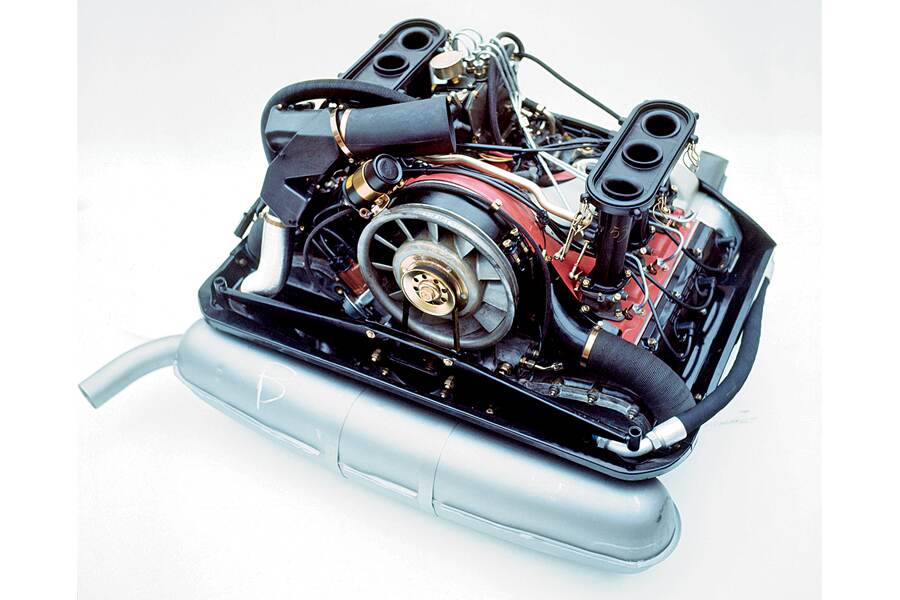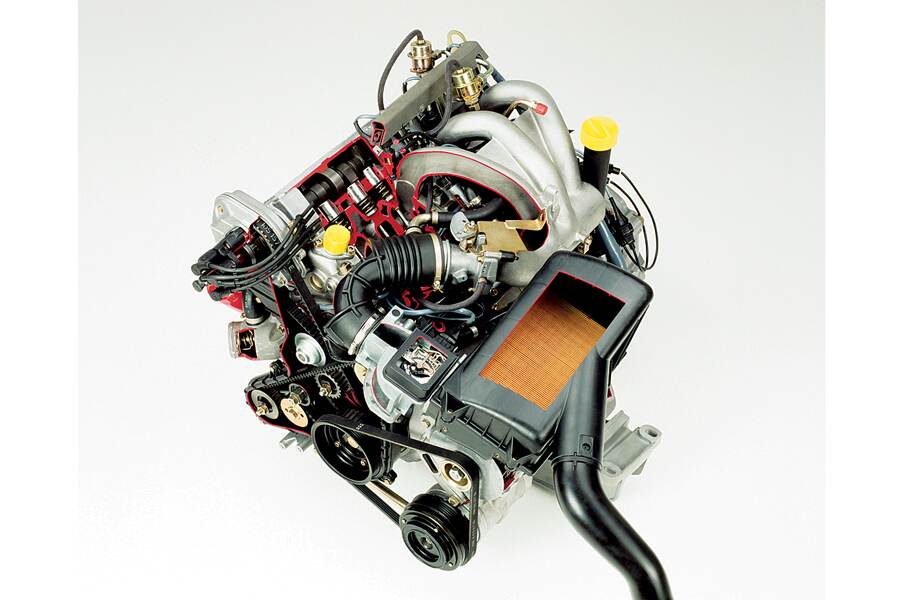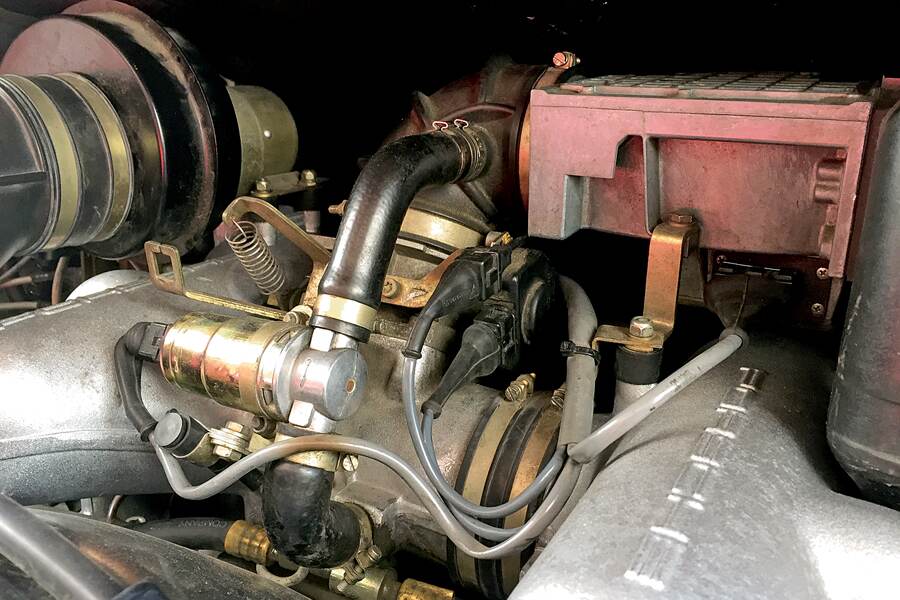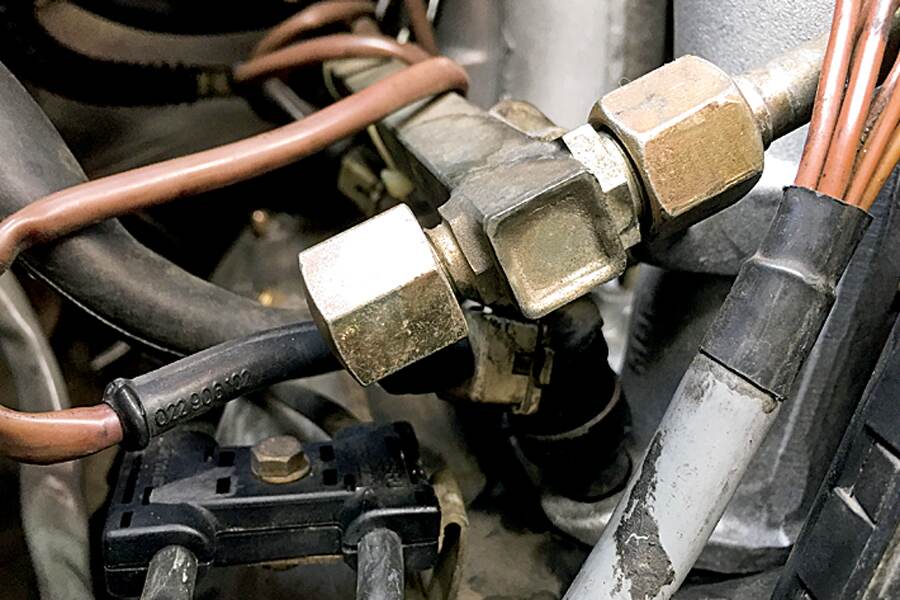In today’s automotive landscape, many of the headlines are being made by the steady progress of the electrification and automation of the automobile. This column has often featured some of this high technology as applied to Porsches, but it is sometimes instructive to look back at prior innovations and their reason for being to better understand how the modern systems came to be. A majority of Porsches on the road today feature an electronic fuel injection (EFI) system, and some of these are over 40 years old!
Regardless of the fuel induction method, there are some basics that apply to all automotive gasoline engines. Gasoline does not combust in liquid form as stored in a car’s fuel tank—it must be in vapor form and mixed with air in order to ignite. Furthermore, because the boiling point of any liquid is directly related to air pressure, fuel vaporization is aided by the relatively low pressure downstream of the throttle plate(s). However, to maximize the potential of the vaporization of all admitted fuel, it must first be atomized, or broken up into very small droplets, before entering the combustion chambers of the engine.
While not terribly accurate at metering fuel, a carburetor is actually quite efficient at fuel atomization due to careful placement of a venturi in the intake throat(s). The venturi is a calibrated restriction that serves to speed up the throughput of air, which also lowers the pressure in this area. The fuel is mixed with the air at the center of the venturi to aid atomization of the fuel and to improve intermixing of fuel and air.
A fuel injection system uses pressurized fuel forced through an injector valve/nozzle to achieve atomization. Porsche used Bosch’s diesel-based mechanical fuel injection (MFI) system in racing engines for decades and in the 1969-1973 911. While a full description of the operation of Bosch MFI is beyond the scope of this article, an important feature of this system is that it operated at about 250 psi, which allowed fine atomization of each precisely measured and timed shot of fuel into the intake ports. This served to promote the evaporative cooling effect of the injected fuel and was quite conducive to the high-revving Porsche racing engines with individual throttle bodies.

Porsche successfully used Bosch’s more emissions-friendly K-Jetronic (or CIS for Continuous Injection System) mechanical injection system for many years on the 911, which continually injected fuel into each of the engine intake ports. While the system pressure of 80 psi still allowed for adequate atomization, some of the fuel would always remain in the intake port until the next intake valve opening event. While this would seem less than ideal, there was always some atomized fuel going into the cylinder, and CIS-equipped engines had special piston crown designs that were designed to generate a tumbling effect to promote intermixing of the air and fuel.
Bosch’s electronic port fuel injection systems use fuel injectors that each contain an electromagnetic solenoid. The injectors are fed a constant supply of pressurized fuel (at about 2.0-2.5 bar, or 29-37 psi in earlier systems) via a common supply tube (often called a fuel rail), for each bank of cylinders, with fuel pressure maintained by a regulating device that restricted the return line to the fuel tank. While the fuel atomization capabilities of the early EFI systems were not as good as their mechanical predecessors, they made up for this deficiency with precise fuel metering and flexibility.
Fuel injection quantity is controlled by varying the amount of injector open time via the length of the pulse-width of the ground signal to the injector negative terminal. Typical fuel injector pulsewidths can be as little as 1.5-2.0 milliseconds (ms, or thousandths of a second) to over 20 ms higher engine speeds and loads. The positive fuel injector terminals are always supplied with voltage while the engine is cranking or running; the switchable ground path needed to complete the circuit and open the injector is controlled by a transistor inside the electronic control unit (ECU).
Bosch D-Jetronic
The four-cylinder Porsche 914 saw Porsche’s first application of electronic fuel injection. Porsche had actually briefly considered Bosch’s D-Jetronic (the “D” stood for druck, the German word for pressure) for use in the 911, but MFI proved to be better suited for the high-revving 911 engine. But, the “D-Jet” system proved to be more than adequate when applied to the low-revving, linear nature of the Volkswagen Type IV engine installed in the 914. The 914’s fuel-injected flat-four employed a single throttle body which fed air into a central intake manifold plenum, with individual intake runners to each intake port; the fuel injectors were mounted between the fuel rails and intake ports.

To calculate the required quantity of fuel to inject into the engine at any given engine running condition, the D-Jet ECU used the speed/density model to estimate airflow into the engine based on analog inputs from an intake manifold pressure sensor, engine rpm (as determined by a pair of trigger points at the base of the ignition distributor shaft), an analog throttle position sensor and an intake air temperature sensor (air density decreases as temperature increases). A cylinder head temperature sensor was present to provide a richer mixture during cold starting and running conditions, and the manifold pressure sensor contained an element that was exposed to the atmosphere to compensate for varying altitudes.
The D-Jet ECU was best described as an analog computer as it contained no digital processing capabilities; the base fuel mixture could actually be adjusted by a knob on the control unit! The ECU also lacked the sensing hardware and ability to provide sequential fuel injection, so the injectors were “batch fired” in pairs. As with CIS injection, any fuel injected against a closed intake valve would remain in the port until the valve opened to draw in the air/fuel charge. Some of the fuel would re-condense on the insides of the intake ports (especially during cold operating conditions), but this “wall film” would vaporize once more after being admitted into the low-pressure area inside the combustion chamber.
D-Jetronic worked quite well in the 914-4 1.7 and 2.0-liter applications, but the pressure sensor and distributor-mounted injector trigger contacts proved to be prone to mechanical wear and subsequent inaccuracy, and the limitations of its primitive ECU precluded the system’s use in a future high-performance application like the 911’s flat-six engine.
L-Jetronic
The 1.8-liter 914-4 of 1974-1976 featured Bosch’s updated L-Jetronic EFI system, which used a vane-type airflow meter to directly measure the quantity (but not the mass) of the air entering the engine. Mounted upstream of the throttle body, the airflow meter used a spring-loaded vane that moved inward as airflow increased; an attached wiper arm was in constant contact with a track of varying electrical resistance. As airflow increased, the resistance value of the wiper track also increased, which lowered the voltage signal to the ECU and signaled it to increase fuel injector pulsewidth.

The direct measurement of airflow offered a more accurate measurement of engine load than the relatively crude D-Jet arrangement, and also offered a means of compensation for engine wear or other changes in airflow such as slightly misadjusted valves. The more sophisticated L-Jet ECU used an engine rpm input from the primary side of the ignition circuit, and the analog throttle position sensor was eliminated in early versions of L-Jetronic. An intake air temperature sensor was integrated in the airflow meter housing, and an auxiliary air regulator (controlled by a simple thermo-time switch and not the ECU) was used to provide a fast idle after cold start to aid engine warmup.
Motronic
Bosch built upon the foundation of the L-Jet system and integrated electronic ignition timing control and fuel control into a single electronic control unit, dubbing the system Motronic; subsequent references to the ECU by Bosch and Porsche refer to it as the DME (digital motor electronics) control unit. The DME control unit featured a central microprocessor to convert the various analog and digital input signals into the digital square wave signal required for fuel injector control; the pulsewidth (and ignition timing/dwell) settings were derived from a three-dimensional map stored on an onboard EPROM (erasable programmable read-only memory) chip.
Porsche’s first utilization of Motronic was in the 1983 944, with the 928 and 3.2-liter 911 following closely behind. These initial applications of the system still featured batch-fired injectors, but the digital ignition dwell and timing controls required accurate measurement of engine speed and position, which was achieved by a pair of inductive sensors. The engine speed sensor generated an analog signal in response to the starter ring gear teeth, and the reference mark sensor signaled that the engine was approaching top-dead center on cylinder #1.
While a basic closed-loop feedback/oxygen sensor system was “piggybacked” onto later versions of the 911 CIS injection system, a heated oxygen sensor system was integrated into Porsche’s Motronic systems to allow for optimal catalytic converter function, along with a limited ability to correct excessively lean or rich air/fuel ratios.

The 16-valve 944S of 1987 featured an updated Motronic system, which added a Hall effect sensor and trigger wheel to the distributor drive, which allowed the DME control unit to determine which cylinder was firing at any given point. This camshaft position sensor allowed the DME to retard the ignition timing of individual cylinders in response to any detonation events (as detected by a pair of dedicated knock sensors threaded into the engine block), as well as enabling true sequential fuel injection. By timing each injection event to occur just before each intake valve opened, the full benefits of fuel atomization from the injector tip could be realized, which resulted in less fuel wastage and smoother idle and part-throttle drivability.
The 1987 928 S4 and 1989 964 also benefited from this updated Motronic system, which also had the ability to store fault codes for a limited amount of irregular running conditions. These fault codes could be read using the Porsche System Tester (PST) scan tool to aid diagnosis.
While the mechanical airflow meter proved to be quite reliable, it was still prone to wear of the electrical wiper tracks, and a severe pop-back through the intake could physically damage the unit by causing the movable vane to drag or get stuck. Furthermore, the airflow meter itself represented a restriction to airflow, which was becoming an issue as Porsche’s engine displacement sizes increased. Contrary to popular belief, this restriction is not from the vane itself (Bosch test data shows a pressure drop of only 0.017 psi across it), but because of the relatively small rectangular slot necessary to meter the airflow.
Mass Airflow Sensing
For both speed-density and vane airflow measurement systems, the amount of airflow into the engine is an indirect estimate of air mass. The ideal air/fuel ratio of a gasoline engine (which is 14.7 parts of air to 1.0 part of fuel) is based upon the mass of the elements involved; because gasoline (hydrocarbon) molecules are much larger and more complex than that of air, the volumetric air-fuel ratio is more like 9,000 to 1!

The 32-valve 928 saw Porsche’s first use of a hot-wire mass airflow (MAF) sensor to replace the vane airflow meter of earlier systems (the 1992 968 featured a MAF sensor, but the 911 did not get this update until the introduction of the 993 series in 1994). The MAF sensor used electronically heated wires mounted within a tube calibrated to match the engine’s mass airflow characteristics. The DME control unit monitors the amount of current necessary to maintain a constant wire temperature; an increase in the mass of air passing through the sensor cools the wires, requiring more heating current from the DME. The MAF signal is used to accurately measure the true mass of the air flowing into the engine, which greatly improves the accuracy of the engine load signal and thus the precision of the fuel injection quantity.
For the 1996 model year, U.S.-bound 993s featured government-mandated second-generation onboard diagnostic (OBD-II) capabilities. While previous (OBD-I) systems could only detect basic malfunctions such as a completely inoperative oxygen sensor or an open or short circuit in the wiring of a sensor, OBD-II monitored the health of the various onboard emission control systems.
Catalytic converter health was monitored by an additional oxygen sensor downstream of each catalyst, and catalyst-damaging engine misfires could be detected by monitoring any sudden deceleration of crankshaft speed (and the offending cylinder could be identified by monitoring the correlation between the camshaft and crankshaft position sensors). The secondary air injection system function was also monitored, along with that of the evaporative/fuel vapor recovery system (which is why a loose fuel filler cap can cause a “check engine” light in OBD-II cars).
The 986 Boxster and 996/997-generation 911s featured an evolution of the Bosch Motronic system with VarioCam variable camshaft timing controls (which actually debuted on the front-engined 1992 Porsche 968), which required a more elaborate shutter wheel design for accurate sensor of the camshaft position. Electronic throttle control appeared on the 1999 996 Carrera 4 and all engines for 2000, which allowed the integration of the torque-reduction feature of Porsche Stability Management (PSM).

The 2002 3.6-liter 996 Carrera and all 2003 and up Boxsters also saw the advent of a returnless fuel system; the fuel return line from the engine bay to the tank was eliminated, and only the amount of fuel actually used by the engine was pumped from the tank and to the fuel rails. This eliminated the problem of heated fuel returning from the engine bay, which increased evaporative fuel emissions.
Direct Fuel Injection
The November 2014 (#223) tech feature goes into detail about Porsche’s direct fuel injection (DFI) systems, but one of the most important aspects of high pressure (up to 1,800 psi in first-generation systems, and over 3,000 psi in current versions) DFI is that it is the first EFI system to surpass the fuel atomization capabilities of the original Bosch timed MFI systems. The evaporative cooling effect imparted by atomization of the fuel charge is further exploited by it being injected directly into the combustion chamber, which greatly improves resistance to detonation and allows higher compression ratios and/or turbocharger boost levels to be realized.
Porsche’s first DFI systems in the 9PA Cayenne and the 987.2 and 997.2 used the same Bosch MAF sensor arrangement as previous versions of the respective engines, but the 970 Panamera of 2010 saw a return to the speed/density method of engine load calculation, with a digital MAP (manifold absolute pressure) sensor as the primary input to the ECU. While this may seem like a backwards step, exponential increases in ECU processing power have largely mooted the advantage of directly measuring incoming air mass. More importantly, the MAF sensor itself was becoming a restriction to intake flow, as it required a tube of a calibrated size and straight, non-turbulent airflow; the voracious appetites of engines like that of the Panamera Turbo and 991 GT3 require a large, unrestricted air intake system!
Besides cost and complexity, one of the main downsides of DFI is that it once again relies upon mechanical parts for its basic function. Like the old Bosch MFI pumps, the engine-driven DFI injection pumps rely on fuel along for cooling and lubrication, which means that they are prone to failure. While Porsche DFI pump failure does not seem to be quite as widespread as it is with some rival German automakers, it is a common enough occurrence that Porsche has superseded the design of DFI pumps several times on many of its engines.
DFI pump failure is often precipitated by a long cranking time while starting the engine, followed by warning lights and reduced engine power. Luckily, the engine is often still able to run (albeit with extremely limited power output) via the low-pressure fuel circuit alone in the event of complete injection pump failure.











